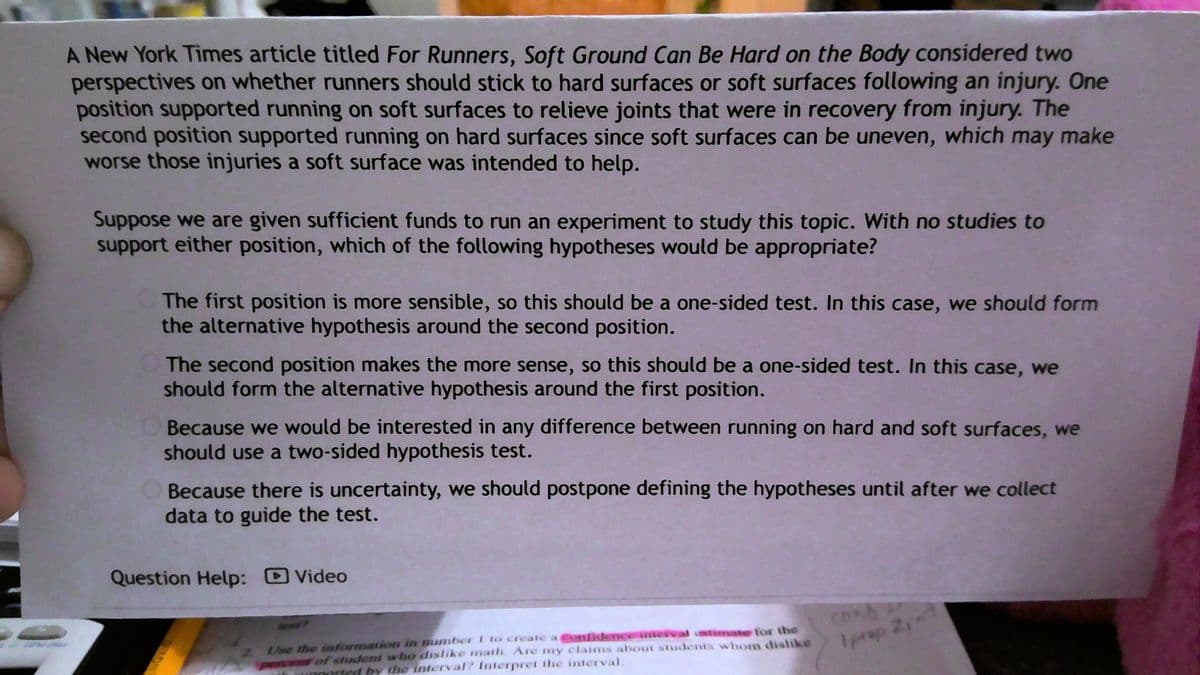A New York Times article titled For Runners, Soft Ground Can Be Hard on the Body considered two perspectives on whether runners should stick to hard surfaces or soft surfaces following an injury. One position supported running on soft surfaces to relieve joints that were in recovery from injury. The second position supported running on hard surfaces since soft surfaces can be uneven, which may make worse those injuries a soft surface was intended to help. Suppose we are given sufficient funds to run an experiment to study this topic. With no studies to support either position, which of the following hypotheses would be appropriate? The first position is more sensible, so this should be a one-sided test. In this case, we should form the alternative hypothesis around the second position. The second position makes the more sense, so this should be a one-sided test. In this case, we should form the alternative hypothesis around the first position. Because we would be interested in any difference between running on hard and soft surfaces, we should use a two-sided hypothesis test. Because there is uncertainty, we should postpone defining the hypotheses until after we collect data to guide the test.
A New York Times article titled For Runners, Soft Ground Can Be Hard on the Body considered two perspectives on whether runners should stick to hard surfaces or soft surfaces following an injury. One position supported running on soft surfaces to relieve joints that were in recovery from injury. The second position supported running on hard surfaces since soft surfaces can be uneven, which may make worse those injuries a soft surface was intended to help. Suppose we are given sufficient funds to run an experiment to study this topic. With no studies to support either position, which of the following hypotheses would be appropriate? The first position is more sensible, so this should be a one-sided test. In this case, we should form the alternative hypothesis around the second position. The second position makes the more sense, so this should be a one-sided test. In this case, we should form the alternative hypothesis around the first position. Because we would be interested in any difference between running on hard and soft surfaces, we should use a two-sided hypothesis test. Because there is uncertainty, we should postpone defining the hypotheses until after we collect data to guide the test.
Algebra & Trigonometry with Analytic Geometry
13th Edition
ISBN:9781133382119
Author:Swokowski
Publisher:Swokowski
Chapter6: The Trigonometric Functions
Section6.4: Values Of The Trigonometric Functions
Problem 22E
Related questions
Concept explainers
Equations and Inequations
Equations and inequalities describe the relationship between two mathematical expressions.
Linear Functions
A linear function can just be a constant, or it can be the constant multiplied with the variable like x or y. If the variables are of the form, x2, x1/2 or y2 it is not linear. The exponent over the variables should always be 1.
Question

Transcribed Image Text:A New York Times article titled For Runners, Soft Ground Can Be Hard on the Body considered two
perspectives on whether runners should stick to hard surfaces or soft surfaces following an injury. One
position supported running on soft surfaces to relieve joints that were in recovery from injury. The
second position supported running on hard surfaces since soft surfaces can be uneven, which may make
worse those injuries a soft surface was intended to help.
Suppose we are given sufficient funds to run an experiment to study this topic. With no studies to
support either position, which of the following hypotheses would be appropriate?
The first position is more sensible, so this should be a one-sided test. In this case, we should form
the alternative hypothesis around the second position.
The second position makes the more sense, so this should be a one-sided test. In this case, we
should form the alternative hypothesis around the first position.
Because we would be interested in any difference between running on hard and soft surfaces, we
should use a two-sided hypothesis test.
Because there is uncertainty, we should postpone defining the hypotheses until after we collect
data to guide the test.
Question Help: Video
ans?
2 Use the information in numtber I to create a Confidence nterval catimate for the
ce of student who dislike math. Are my claims about studtents whomn dislike
Iprap 2,-
bY the interval? Interpret the interval.
Expert Solution
This question has been solved!
Explore an expertly crafted, step-by-step solution for a thorough understanding of key concepts.
This is a popular solution!
Trending now
This is a popular solution!
Step by step
Solved in 2 steps

Knowledge Booster
Learn more about
Need a deep-dive on the concept behind this application? Look no further. Learn more about this topic, statistics and related others by exploring similar questions and additional content below.Recommended textbooks for you

Algebra & Trigonometry with Analytic Geometry
Algebra
ISBN:
9781133382119
Author:
Swokowski
Publisher:
Cengage

Algebra & Trigonometry with Analytic Geometry
Algebra
ISBN:
9781133382119
Author:
Swokowski
Publisher:
Cengage